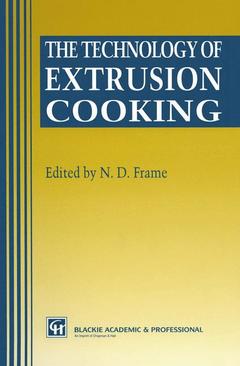Description
The Technology of Extrusion Cooking, 1994
Coordinator: Frame N.D.
Language: English
Subject for The Technology of Extrusion Cooking:
Keywords
cereals; chemistry; corn; development; energy; experiment; fats; food; food technology; processing; quality; quality control; rheology; system; temperature
Publication date: 10-2012
253 p. · 15.5x23.5 cm · Paperback
253 p. · 15.5x23.5 cm · Paperback
Description
/li>Contents
/li>
Extrusion cooking is a specialist area of food technology because of the complexity of the interactive effects which are inherent in the system. General predictive modelling is very difficult because ingredients are diverse and can vary considerably. Modelling tends to be product specifi- new product development tends to be by experimental designs and good fortune. The emphasis of this book is on the latest and potential applications of twin screw extrusion in food production, specifically co-rotating inter meshing screw extruders. Of course, in order to develop products and maximise the extruder potential in terms of energy, product quality and output, an overall understanding of the material flow mechanism, barrel fill length and rheology is essential. The book aims to give explanations and general guidance with examples of screw design, configuration and operat ing parameters for a variety of product categories. It is also intended to help production operators diagnose the symptoms of particular problems such as temperature control, quality variation, raw material inconsistency, etc. For the product development technologist there is more than one way to make a similar product. For example, equipment manufacturers recom mend difficult methods for producing flaked corn. In addition, their machines may differ from each other in terms of screw design, power/ volume ratio, screw tip/barrel clearance, etc. , making scale-up more prob lematic.
1 Operational characteristics of the co-rotating twin-screw extruder.- 1.1 Types of extruders.- 1.1.1 Single screw.- 1.1.2 Co-kneaders.- 1.1.3 Counter rotating.- 1.1.4 Co-rotating.- 1.2 Process characteristics of the t.s.e..- 1.2.1 Feeding.- 1.2.2 Screw design.- 1.2.3 Screw speed.- 1.2.4 Screw configurations.- 1.2.5 Die design.- 1.2.6 Barrel temperature and heat transfer.- 1.2.7 Scale-up.- 1.2.8 Process flow charts.- 1.3 Ancillary processes.- 1.3.1 Preconditioning.- 1.3.2 Devolatilisation.- 1.4 Raw materials.- 1.5 Practical operation of the t.s.e.—start up, shut down and control.- 1.6 Glossary.- References.- 2 Raw materials for extrusion cooking processes.- 2.1 Introduction.- 2.2 Structure-forming raw materials.- 2.2.1 Structure-forming raw materials based on starch.- 2.2.2 Protein-rich raw materials.- 2.3 Raw materials acting as fillers in the extrudates.- 2.3.1 Proteins.- 2.3.2 Starches.- 2.3.3 Fibrous materials.- 2.4 Raw materials as plasticisers and lubricants.- 2.4.1 Water.- 2.4.2 Oils and fats.- 2.4.3 Emulsifiers.- 2.5 Raw materials acting as nucleants for gas bubble formation.- 2.6 Raw materials acting as flavours.- 2.6.1 Salt.- 2.6.2 Sugar.- References.- 3 Breakfast and cereal extrusion technology.- 3.1 Introduction.- 3.2 What is a breakfast cereal?.- 3.3 A closer look at the products.- 3.4 Breakfast cereal processes.- 3.5 Principles of cooking.- 3.6 Overview of cooking processes.- 3.6.1 Boiling water cookers.- 3.6.2 Steam cookers.- 3.6.3 Adiabatic extrusion.- 3.6.4 High shear cooking extrusion.- 3.6.5 Low shear, high pressure cookers.- 3.6.6 Low shear, low pressure cookers.- 3.6.7 Continuous steam pre-cooking.- 3.7 Breakfast cereal processes: traditional and extrusion methods.- 3.7.1 Flaked cereals.- 3.7.2 Extrusion puffed breakfast cereals.- 3.7.3 Oven puffed cereals.- 3.7.4 Gun puffed cereals.- 3.7.5 Shredded products.- 3.7.6 Pre-cooked hot cereals.- 3.8 Conclusion.- References.- 4 Snack food extrusion.- 4.1 Introduction.- 4.2 Ingredients.- 4.2.1 Cereals.- 4.2.2 Root crops.- 4.2.3 Process aids.- 4.3 Equipment review.- 4.3.1 Mixing equipment.- 4.3.2 Feeders.- 4.3.3 Conditioning cylinders.- 4.3.4 Extruders.- 4.3.5 Dryers.- 4.3.6 Fryers.- 4.3.7 Coaters.- 4.4 Direct expanded products.- 4.4.1 Process description.- 4.4.2 Fried collets.- 4.4.3 Baked collets.- 4.5 Co-extruded snacks.- 4.5.1 Process description.- 4.5.2 Formulation.- 4.5.3 Miscellaneous.- 4.6 Indirect expanded products.- 4.6.1 Pellets.- 4.6.2 Fabricated chips.- 4.7 Die and cutter design.- 4.7.1 Die plates.- 4.7.2 Die holes.- 4.7.3 Effect of expansion forces.- 4.7.4 Effect of viscoelastic forces.- References.- 5 Petfood and fishfood extrusion.- 5.1 Introduction.- 5.2 Raw material characteristics and selection.- 5.2.1 Protein sources.- 5.2.2 Starch sources.- 5.2.3 Fat, fibre and ash consideration.- 5.2.4 Minor ingredients.- 5.2.5 Typical formulations.- 5.2.6 Raw material preparation.- 5.3 Selection of hardware.- 5.3.1 Feeding devices.- 5.3.2 Preconditioning considerations.- 5.3.3 Extruder barrel selection.- 5.3.4 Die/knife design.- 5.3.5 Ancillary process equipment.- 5.4 Processing variables.- 5.4.1 Preconditioning.- 5.4.2 Extrusion.- 5.4.3 Process control.- 5.5 Final product specifications.- 5.5.1 Quality control.- 5.5.2 Troubleshooting techniques.- 5.6 Evaluation of operational costs.- 5.7 Conclusion.- References.- 6 Confectionery extrusion.- 6.1 Introduction.- 6.2 Processing.- 6.2.1 Pre-extrusion processes.- 6.2.2 Cooker extruder profiling.- 6.2.3 Addition and subtraction of materials.- 6.2.4 Shaping and forming at the die.- 6.2.5 Post-extrusion processes.- 6.3 Flavours and other special ingredients for confectionery extrusion.- 6.4 Liquorice.- 6.5 Toffees, caramels and fudges.- 6.6 Boiled sweets.- 6.7 Sugar crust liqueurs.- 6.8 Pressed tablets.- 6.9 Creams, pastes and lozenges.- 6.10 Gums.- 6.11 Jellies.- 6.12 Cocoa and crumb.- 6.13 Chocolate.- 6.14 Reaction chamber products.- 6.15 Aerated confections.- 6.16 Chewing gum.- 6.17 Frozen confectionery.- 6.18 Croutons.- 6.19 Three-dimensional confections.- 6.20 Confections by half products.- 6.21 Other areas.- 6.22 Conclusion.- Acknowledgements.- References.- 7 Extrusion of brewers’ hops.- 7.1 Introduction.- 7.2 Application of extrusion technology to the production of bitterness in beer.- 7.2.1 Background.- 7.3 Development of extrusion technology in hop processing.- 7.4 Process chemistry—choice of alkaline salt.- 7.5 Composition and quality of extruded hops.- 7.6 Experimental brewing studies with extruded hops.- 7.7 Process development to commercial scale production.- 7.8 Conclusion.- References.
© 2024 LAVOISIER S.A.S.

